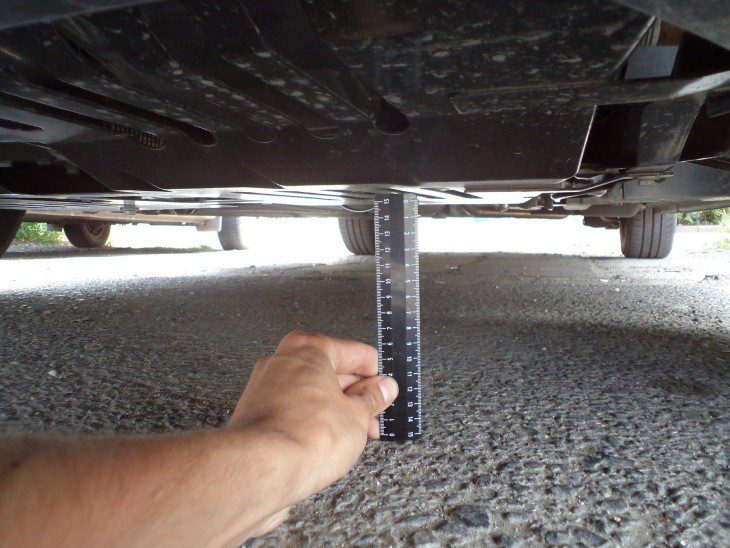
What is vehicle clearance
Content
- What is vehicle clearance
- Determining factor
- What are the ground clearance?
- Not satisfied with the clearance: is it worth doing something
- How do I change the ground clearance?
- Why is it important to know this distance?
- How to measure yourself?
- A few words about overhangs
- Typical ground clearance values for passenger cars
- What is the optimal clearance height?
- When is it worth increasing the ground clearance and how to do it?
- And what about the lowered clearance?
- How to choose the clearance for the car?
- Note
- What you need to know
- Related videos
- Questions and answers:
Choosing a new car, the buyer is guided by different data: the engine power, dimensions and body type. But in the car dealership, the manager will definitely pay attention to the clearance.
What does this parameter affect and can it be changed in your car? Let's try to understand these issues.
What is vehicle clearance
When driving, the vehicle should only cling to the road surface with its wheels. This is one of the main factors for ensuring your ride comfort. The distance between the bottom of the car and the road is called the clearance.
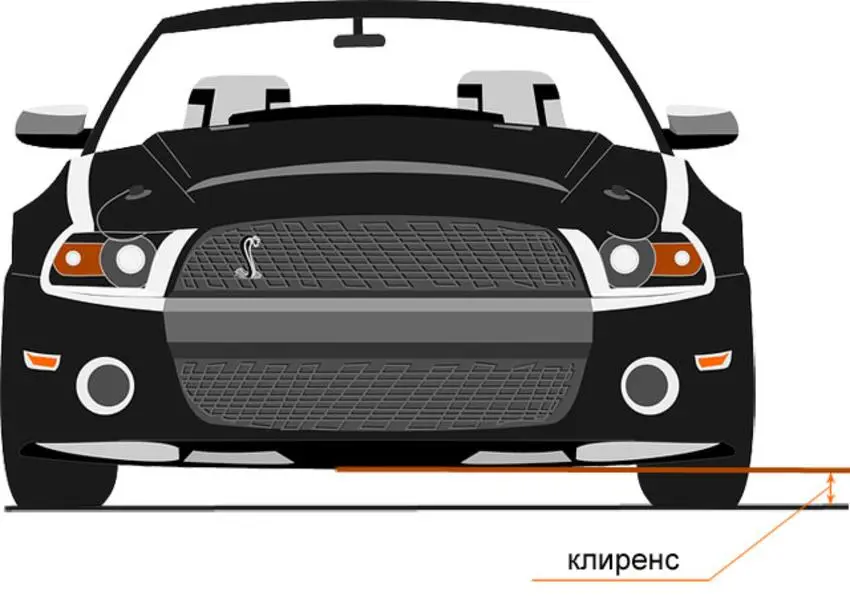
More precisely, it is the height from the road surface to the lowest point in the car. When purchasing transport, first of all, you need to take this value into account. No matter how powerful and comfortable transport is, if it constantly touches the road, it will quickly break down (important elements are often located at the bottom of the car, for example, the brake line).
By the size of the clearance, motorists determine how passable the car will be, and whether it can be driven on specific roads. However, in addition to cross-country ability, ground clearance affects vehicle stability on the road. Because of this, the high ground clearance will allow the machine to overcome obstacles (for example, when traveling on country roads with deep holes). Low clearance will provide better downforce, and with it more effective grip and cornering stability (we will talk about the practicality of this solution a little later).
Determining factor
For most motorists, the concept of vehicle clearance is the same as the distance from the ground to the lower edge of the front bumper. The reason for this opinion is that when driving on roads with poor coverage, it is the bumper that most often suffers. A broken bumper is also seen in those cars whose drivers like to park close to curbs or snowdrifts in winter.

Although the height of the front bumper plays a big role in determining the vehicle's ride height, its edge is not always the lowest point of the vehicle. In cars of different classes, the height of the front bumper will be different:
- For passenger cars (sedans, hatchbacks, station wagons, etc.), this parameter varies from 140 to 200 millimeters;
- For crossovers - from 150 to 250 millimeters;
- For SUVs - from 200 to 350 millimeters.
Of course, these are average numbers. Many modern bumpers are additionally equipped with a protective skirt made of soft rubberized plastic. When the driver parks his car as close as possible to a vertical obstacle (for example, a curb), the skirt clings to it and a strong rattle is heard in the car.
To prevent damage to the skirt or the bumper itself during parking, the manufacturer equips vehicles with parking sensors. In many cases, this system either creates an audible warning or displays a video of the area directly in front of the bumper. The lower the parking sensors are installed, the more likely it is to detect a dangerous obstacle in front of the car.
What are the ground clearance?
In the technical literature of transport, this parameter is indicated in millimeters, however, there are such mechanical means in which the clearance can reach two meters (tractors for processing cotton fields). In passenger cars, this parameter varies from 13 to 20 centimeters.
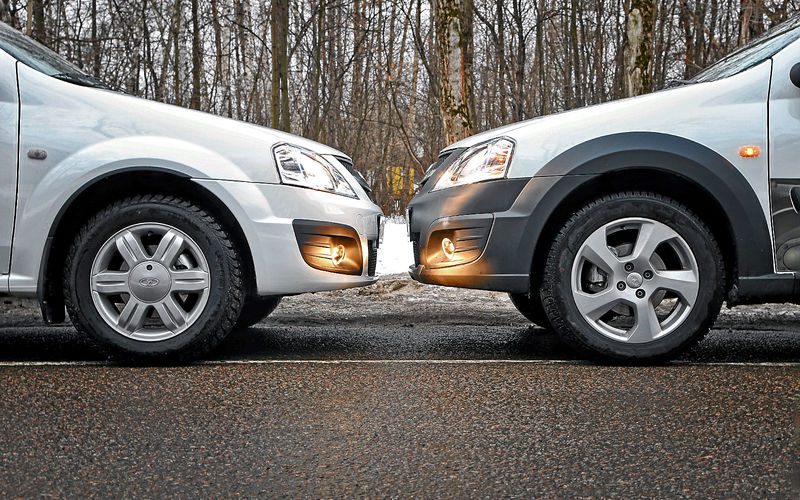
SUVs have high ground clearance. Here are some "record holders":
- Hummer (model H1) - 41 centimeters (slightly below the height of some tractors, for example, at MTZ it reaches 500 mm);
- UAZ (model 469) - 30 cm;
- In the first generation Volkswagen Touareg model, equipped with air suspension, the ground clearance can be changed, and the height of the car varies from 237 mm to 300 mm;
- The Niva (VAZ 2121) has a clearance of 22 cm.
Depending on the type of suspension and the design features of the car, the ground clearance will decrease if passengers sit in the cabin and put a heavy load in the trunk. The vehicle weighs heavier, the suspension sags, and the vehicle becomes lower. For this reason, in order for a low car to drive more safely on a hilly section of a dirt road, the driver can ask everyone to get out of the vehicle.
Not satisfied with the clearance: is it worth doing something
If there is such an opportunity, then if the clearance is not suitable, it is better to transfer to another car. In this case, you can choose the model that has a higher ground clearance from the factory. Of course, this path is not cheap, especially if you cannot sell your car on the secondary market at an affordable price.
Here are a few other things you can do to raise your car:
- Instead of regular wheels, install disks with an increased radius or put tires with an increased profile. With such an upgrade, the first thing the speedometer will show is the wrong speed, and the odometer will incorrectly calculate the distance traveled. In this case, it is necessary to independently calculate the error and multiply the actual instrument readings by the coefficient calculated in advance. Also, a modified rubber profile or wheel diameter will affect the vehicle's handling for the worse.
- Upgrade the suspension of the car by installing higher shock absorbers. Such tuning also has some disadvantages. First of all, experts will help you choose the right dampers so that this does not greatly affect the comfort while driving. If the car is still under warranty, then such an upgrade may lead to the refusal of the service center to carry out free maintenance due to interference with the design of the car.
- Install autobuffers. In this case, the machine will not lower so much when loaded. But at the same time, spacers in the springs make the suspension stiffer, which will also negatively affect ride comfort.
How do I change the ground clearance?
Some car owners tweak the vehicle's ground clearance to increase flotation or to make it more stable when cornering. It all depends on the area in which the transport will travel.
To overcome rough terrain, you need a high ground clearance so as not to damage the engine or other elements located closer to the ground. Driving on the highway will require a low ground clearance, because in this case there are fewer holes on the road (although this depends on the terrain - in some areas only an SUV is needed).

There are several ways to underestimate, or vice versa - to increase ground clearance. Here are some of them:
- Install custom wheels. If discs with a smaller diameter are installed, this may not be very nice. But when installing discs of a larger radius, additional bodywork may be required, for example, increasing the size of the wheel arches;
- Installation of seals on the suspension spring. Car dealerships sell special hard rubber spacers that can be installed between the turns. This can make the car taller, but the spring will lose its elasticity. You have to be prepared for a tough ride. This method has one more drawback - all shocks will be damped to a lesser extent, which will negatively affect the design of the vehicle;
- Some car manufacturers have developed an adaptive suspension. Depending on the selected mode, the system itself is able to change the clearance. Plus in this way - the car can overcome any roughness of the off-road, but as soon as the road becomes level, the car can be lowered and adapted for fast driving. The disadvantage of such a modernization is that the air suspension costs decent money, which is why it is not suitable for owners of modest material wealth;
- Installation of higher racks or vice versa - lower ones;
- Removing the engine protection. This element reduces the distance from the lowest point of the car to the road, but the vehicle height itself does not change.

It should be noted that this kind of auto-tuning has several significant drawbacks. First, changing the wheel radius will affect the accuracy of the speedometer and odometer readings. And if the chassis of the car is equipped with additional sensors, their work may also be incorrect. For example, the control unit will receive data on wheel revolutions, but this information will not correspond to reality, due to which the amount of fuel will be incorrectly calculated, etc.
Secondly, making changes to the design of the car will negatively affect the quality of the trip and its stability on the road. This often has a negative effect on the steering gear and suspension. Increasing the clearance leads to an increase in the off-road capability of the vehicle, but has a negative effect on its behavior at high speed.
The same can be said about those who want to make a sports car out of their iron horse. If you install equipment that underestimates the car, then you need to be prepared to make certain compromises. So, the modernized transport will make it possible to drive only on flat roads, and the engine protection will constantly cling to various irregularities.

Thirdly, in some countries, changes in the design of a car without an appropriate permit are punishable by law, and the car tuning enthusiast will be forced to pay a fine.
Features of measuring the size of clearance
How to correctly measure the clearance value? Some do this by determining the distance from the bottom of the bumper to the road. However, in most cases this is not the correct procedure. The fact is that the rear bumper will always be higher than the front one, and the front car is often lower. In addition, many bumpers have a rubber skirt that is specially lowered to warn the driver when an obstacle is too high.
Many motorists consider the bumper to be the lowest point of a car, since most often this part suffers when parking near a curb or when a vehicle runs into a high obstacle. In fact, when the car brakes, its body always tilts forward a little, so the front bumper most often clings to different hills.
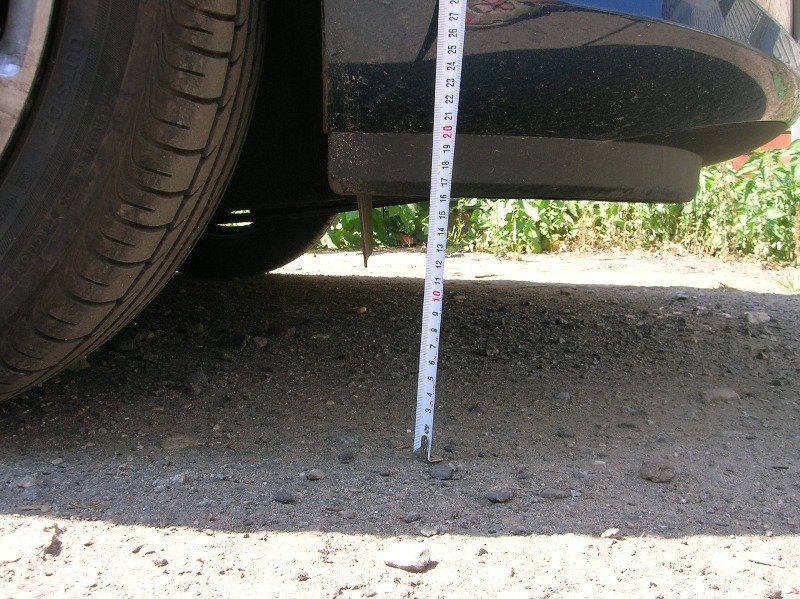
However, on many car models, even the front bumper is not the closest point to the ground. Often this part is made in such a way as to increase the exit angle - this is when the car descends from a high hill onto a flat road. Such conditions are found in multi-level parking lots and car overpasses.
Here's how to measure the clearance height:
- The car must be loaded, as in normal conditions - the driver's weight, the tank is slightly not full, the spare tire in the trunk and medium-sized luggage (up to 10 kilograms);
- We put the car on the pit;
- A level and solid object (a level is best) fits under the car across the width of the wheels. Suspension and brake elements are not taken into account when measuring, since they rarely cling to a car;
- We measure the clearance at several points. And the first one is under the engine, namely in the lowest section of the motor protection (it should not be removed, since it prevents the ICE from critical hits against obstacles on the road). The second point is the stretcher. The level is placed under the car and the height is measured at several points. The smallest value will be the vehicle clearance. This is for the front;
- The lower point of the car in the stern will be the rear beam. The procedure is identical to the previous one. As in the first case, the protrusions of the suspension and brake system are also not taken into account here - they do not affect the determination of the passability of the car.
Another parameter that must be taken into account when determining the passability of the machine is the exit angle. Of course, no one walks on the road while driving to measure every unevenness. Nevertheless, at least visually, you need to get used to how close the driver can park to the curb, or what the maximum track depth is allowed in winter so as not to spoil the bumper.
Here is a short video on how to measure this parameter:
As for the magnitude of the angles of exits / entrances, it directly depends on the length of the part of the car located on the outer side of the wheels from the front to the rear, that is, the length from the end of the bumper to the wheel arch. The longer the hood, the more difficult it will be to drive up a steep hill, such as a tow truck.
Why is it important to know this distance?
The highest ground clearance gives the driver confidence that the car will be able to overcome a serious obstacle, whether it be a snowdrift, a steep entrance to an overpass, etc. without harm to the vehicle.
It is important to pay attention to this parameter before buying a new car. Most modern models of passenger cars have a clearance of around 160 millimeters. For operation in a large city with good quality roads, such ground clearance is quite enough.
But if the driver periodically travels to country roads, then he will need not only a stronger car, but also a vehicle with increased ground clearance. When choosing a car, you need to consider these factors. But in most regions of the post-Soviet space, even in large cities, the roads leave much to be desired, so it would be more practical to opt for a car with high ground clearance.
How to measure yourself?
The complexity of measuring the clearance lies in the need to get under the vehicle. Often it turns out to correctly determine this parameter from the inspection hole. Regardless of the chosen method (the car is standing on even asphalt or it is standing above the pit, and there is a flat bar under the car), the lowest point of the car is first visually determined.
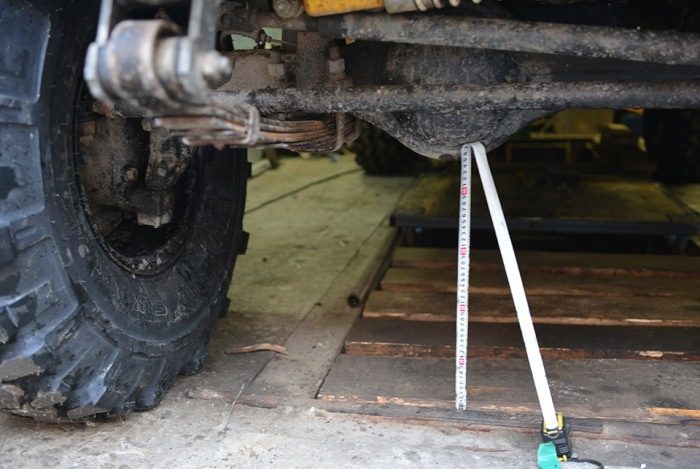

Using a tape measure or ruler, measure the distance from this point to the horizontal line below it. The smallest value, if a measurement is made in several parts of the car, will just be the clearance of the car. It is incorrect to measure the distance from the lower edge of the bumper to the ground.
In order for the clearance to be determined correctly, measurements must be taken not on a lightweight car, but with a standard load (full tank of fuel, the weight of the driver and one passenger). The reason is that the car never drives without loading. At least there is some fuel in the tank, the driver and at least one passenger are sitting in the cabin.
A few words about overhangs
Often in the technical documentation of the car, the height of the front and rear overhangs is mentioned. This is the distance from the farthest point of the lower edge of the bumper to the road. The larger this parameter, the less likely it is to damage the bumper when parking near curbs.
The angle of exit/entry is also of great importance. This parameter is directly related to the length of the bumper. The shorter the bumper, the greater the angle, and the less likely it is to hit the road with the bumper when driving into a steep entrance to a parking lot or overpass. The same applies to steep exits.
Typical ground clearance values for passenger cars
On the territory of the CIS countries, domestic cars are still popular among residents of small towns and villages. The reason is not only the cheapness and availability of spare parts for such vehicles.
Often a foreign car cannot cope with bumps on the roads due to low ground clearance. Therefore, the driver has to drive too slowly and carefully on such roads. The domestic car has a high ground clearance (the lowest point is at a distance of about 180-190 millimeters from the ground), which gives it some advantage on bumps.
If the car drives on snow-free and more or less flat roads, then the standard clearance in the range from 120 to 170 millimeters is quite enough for such conditions. Most modern cars have just such a clearance range.


If necessary, periodically or often go on roads with poor coverage or on a primer, then it is better to opt for a crossover. Many manufacturers in the lineup have crossovers built on the basis of a passenger car. The difference between these models is precisely the increased ground clearance.
Basically, crossovers are built on the basis of a hatchback (hatch-cross). Such cars are designed to attract a larger audience to their favorite model, but who are not suitable for standard passenger vehicles due to low ground clearance. But in the assortment of many manufacturers there are separate models of crossovers that have greater cross-country ability and are in the same price segment as typical passenger cars.
What is the optimal clearance height?
To determine if a particular car meets the manufacturer's standard, you just need to compare the indicators. So, the norm for light four-wheeled vehicles is a clearance of 120 to 170 millimeters. A typical crossover should have a ground clearance height of 17-21 centimeters. For SUVs, the norm is more than 200 millimeters.
Next, we will consider the cases when car tuning enthusiasts decide to increase, and sometimes even lower the ground clearance.
When is it worth increasing the ground clearance and how to do it?
The first to think about the need for this procedure are the owners of budget SUVs or crossovers. Often these models have a body in the shape of an SUV, but have the characteristics of a conventional passenger car. But since the manufacturer has provided for such a body shape, this encourages the owners of such specimens to test their vehicles in off-road mode.
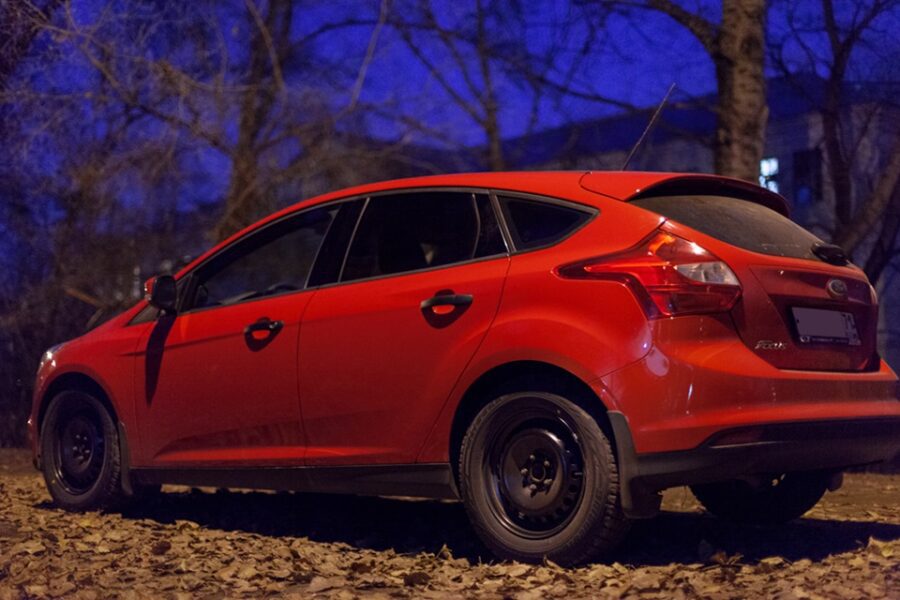

And the first thing such motorists do is increase the clearance so as not to damage the bottom and attachments. The easiest way to do this is with high-profile tires or larger discs.
Often, motorists change this parameter not only for entertainment purposes. The fact is that if the car is loaded, then on the off-road it will definitely catch on the bottom somewhere or damage the engine protection. Another reason is when the car strikes the ground, falling into a deep rut (this often happens in winter on unclean roads).
Installing high custom racks is also an effective, but more expensive method. Some modifications of such shock absorbers - the ability to adjust their height, but you will need to spend even more money on this, and it is not at all interesting to kill such a suspension off-road (by the way, there is a separate review).
What does the increased ground clearance give?
This upgrade has two sides of the coin. A plus will be increased cross-country ability - even if you have to park as close to the curbs as possible, the driver in most situations will be confident in the safety of the underbody. Also, in a deep rut, the car will not "sit on its stomach" so often, which will be a pleasant bonus for any driver overcoming a snowy road.


On the other hand, a tall car has a higher center of gravity, so on bends you need to be more careful and slow down before turning. Due to the weak downforce, the braking distance is increased.
And what about the lowered clearance?
As for lowering the clearance, there is no need for this, at least from the point of view of practicality. Most often this is done for aesthetic reasons. And that is a matter of taste. Some car owners invest a lot of money in upgrading their car, but the vehicles crawling along the road do not look cool at all.
You won't be able to drive fast in such a car, because when accelerating and braking, the body necessarily tilts. On an understated car, this will be accompanied by a constant breakage of the bumper or a terrible grinding and a spectacular emission of sparks from damage to the engine protection. To avoid this, you will need to install a sports suspension. But driving such a car on normal roads is like driving a car without shock absorbers.


Moreover, even if you drive such a car around the city in "slow life" mode, the very first kilometer - and you will have to invent something to crawl over the speed bump. For onlookers with mobile phones, this will definitely be interesting.
But even if you do not drive the car to such madness, this procedure will not add practicality to household transport. But as for sports cars, here the low ground clearance plays an important role. Corner downforce then plays a key role in the agility of a sports car.
Here are a few more reasons not to underestimate your car:


Watch this video on YouTube
How to choose the clearance for the car?
If the choice of design and option package is a matter of personal preference, then choosing a car by clearance is more of a necessity than a matter of taste. If the car is operated on roads with European quality, then the ground clearance can be very low.
For sports cars, this is an important parameter, since with high ground clearance at a decent speed, downforce can be lost, which is why sometimes sports cars can lift off the ground, losing traction on the wheels.
If the driver lives in the territory of the post-Soviet space, then even in the conditions of the city, experts recommend buying a car with at least a clearance of 160 millimeters. In summer, it may seem that the car may be lower, but in winter, on a poorly cleared road, even such a clearance may not be enough.
Note
When tuning a vehicle to give it more sportiness, car owners install bumpers with a lower edge than the standard version. If the car participates in sports competitions, then this is even beneficial, since sports bumpers improve the aerodynamics of the car.
But for everyday use, even in urban environments, this is not the best idea. The reason is that everyday trips are accompanied by the need to drive through speed bumps or park near the curb. An expensive and beautiful bumper with a low edge in such situations often suffers the most.


Therefore, before subjecting your car to such tuning, it is necessary to assess all the risks of damage to the bumpers. If the machine will be operated on country roads, then its clearance should be sufficient so that crankcase protection can be installed, which will protect the oil pan from breakdown.
What you need to know
If you plan to operate the car in off-road conditions, in addition to the clearance of the car, the car owner must take into account other parameters of the geometry of the car body. Here's what you need to pay attention to:
- longitudinal stability. This is the maximum slope angle at which the vehicle remains stable, or the contact of all wheels with the road surface. Knowing this parameter, the driver can control the moment of the vehicle rollover in the longitudinal direction (forward or backward).
- transverse stability. This is the maximum vehicle roll angle at which the vehicle maintains all wheel contact with the road surface. Knowing this parameter, the driver will be able to control the moment the car rolls over to one side.
- Departure corner. This is the angle between the contact patch of the rear wheel with the road and the outer part of the rear bumper. This parameter is important not only for vehicles operating in off-road conditions. Multi-level car parks and overpasses often have a steep angle to save space. Due to the discrepancy between the exit angle and the identical parameter in the car, the car can cling to the rear bumper at a time when the wheels are already on the horizontal part of the road, and the rear bumper is still above the exit.
- Entry angle. This is the angle between the contact patch of the front wheel with the road and the outer part of the front bumper. As in the case of the exit angle, this parameter is important when entering an overpass or multi-level parking.
- Ramp angle. This is the angle that is formed by the three points of the car: the contact patch of the front wheel, the contact patch of the rear wheel with the road surface and the middle of the bottom between the wheels. This angle is important when the car overcomes small but high hills, for example, custom-sized speed bumps. In this case, the maximum height of the central part of the vehicle is an important factor. Vehicles with a short wheelbase will have a sharper ramp angle, which means that with a combination of high approach and exit angles, such a vehicle will more confidently overcome a small hilly pavement. An example of this is the excellent geometric cross-country ability of the Suzuki Jimny SUV against the Ford Explorer or other long-wheelbase equivalent.
- Depth of ship. This is a conditional horizontal line, which is much higher than the clearance of the car. This parameter allows the car to overcome a stream of water or a huge puddle so that water does not seep into the interior of the car or damage the electrical equipment in the engine compartment. In models capable of overcoming a deep ford, the generator, starter and other electrical equipment are installed as high as the design of the car allows.
Related videos
In conclusion, a short video on how you can independently increase the clearance of a car without a significant modernization of its design:


Watch this video on YouTube
Questions and answers:
What is low ground clearance? Sports cars and some sedans have low ground clearance. It ranges from 9 to 13 centimeters. High ground clearance in SUVs is at least 18, maximum 35 centimeters.
What should be the clearance? The optimum clearance is between 15 and 18 centimeters. This allows you to operate the machine in different conditions: both in the city and on country roads.
What is ground clearance? Ground clearance refers to the vehicle's ground clearance. This is the distance from the lowest element of the car (often the sump of the engine) to the road surface.
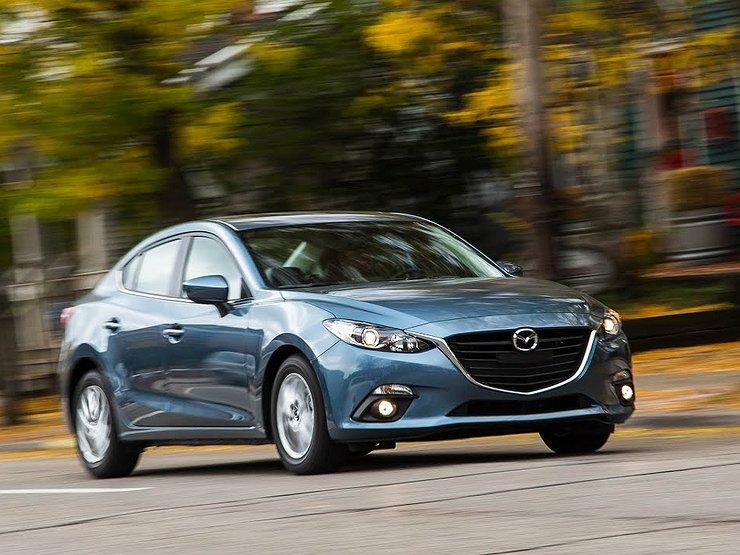

One comment
Polonez
Slowly ... It's nice that you started to explain all these issues, but with the measurement of the ground clearance it is not like that. 80% of the vehicle width between the wheels is taken into account. Otherwise, there would be a problem with, for example, protruding suspension elements or brakes. And, for example, what about the XNUMXxXNUMX with the reduction gears sticking out of the wheels?